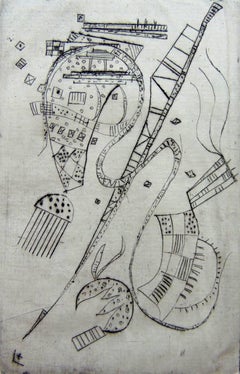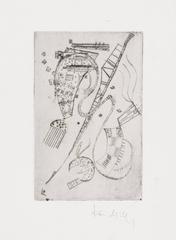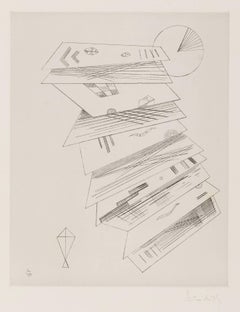Kandinsky And Etching
1930s Surrealist Figurative Prints
Etching
1910s Abstract Abstract Prints
Drypoint
1960s Abstract Abstract Prints
Etching
1960s Abstract Abstract Prints
Etching, Aquatint
1960s Abstract Geometric Animal Prints
Etching
Recent Sales
1930s Abstract Abstract Prints
Etching
1930s Modern Abstract Prints
Etching
1930s Abstract Expressionist Prints and Multiples
Etching
1930s Abstract Abstract Prints
Drypoint, Etching
1930s Abstract Geometric Abstract Prints
Etching
1930s Abstract Prints and Multiples
Etching
1920s Abstract Prints
Drypoint
1950s Symbolist More Prints
Watercolor, Etching
1930s Abstract Geometric Abstract Prints
Etching
1960s Abstract Geometric Animal Prints
Etching
1930s Abstract Geometric Abstract Prints
Drypoint, Etching
1960s Abstract Abstract Prints
Etching
1960s Abstract Abstract Prints
Etching
1930s Modern Abstract Prints
Drypoint, Etching
20th Century Bauhaus Abstract Prints
Drypoint, Etching
People Also Browsed
21st Century and Contemporary Italian Pillows and Throws
Velvet
1970s Surrealist Figurative Prints
Paper, Engraving
1880s Abstract Expressionist Abstract Prints
Archival Paper, Etching, Aquatint
1970s Modern Abstract Prints
Archival Paper, Lithograph
1910s American Impressionist Landscape Paintings
Canvas, Oil
Vintage 1940s French Art Deco Dining Room Tables
Laminate, Oak
Vintage 1930s Italian Art Deco Cabinets
Glass, Mirror, Wood, Maple, Walnut, Parchment Paper
1950s Modern Figurative Prints
Lithograph, Stencil
21st Century and Contemporary Italian Modern Coffee and Cocktail Tables
Blown Glass
2010s Modern Landscape Paintings
India Ink, Acrylic, Handmade Paper
1920s Impressionist Landscape Paintings
Canvas, Oil
Vintage 1930s French Neoclassical Settees
Wood, Velvet
Vintage 1960s French Modern Paintings
Wood, Paper
1990s Prints and Multiples
Offset
21st Century and Contemporary French Art Deco Wall Mirrors
Bronze
2010s Contemporary Landscape Paintings
Linen, Oil
Kandinsky And Etching For Sale on 1stDibs
How Much is a Kandinsky And Etching?
Wassily Kandinsky for sale on 1stDibs
“Color is a means of exerting a direct influence upon the soul,” wrote the pioneering abstract artist Wassily Kandinsky. The Russian-born painter and theorist dedicated his life to using abstract compositions of form and color to express deep emotion as well as to depict the language of music through visuals.
Kandinsky was part of a crucial moment in art history — the early 20th century — that saw the rise of movements like Cubism. He embraced styles such as Surrealism and Fauvism and was a leading figure in bringing together Der Blaue Reiter (the name means “The Blue Rider” after one of Kandinsky’s paintings) in 1911, a group of avant-garde artists in Munich, including Paul Klee and Franz Marc, who explored spiritual concepts through their art as a response to the materialism of the time. Kandinsky also led courses on analytical drawing and color at the Bauhaus. He was appointed by founder and architect Walter Gropius to teach in Weimar in 1922. He taught at all three of the legendary school’s locations and remained with the institution until its forced closure by the Nazi party in Berlin.
The artist had the rare and unusual trait of synesthesia, the neurological ability to perceive things using multiple senses. In Kandinsky’s case, it was the gift of “seeing” music, and music appeared in every aspect of his work, including the titles of his series “Compositions,” “Improvisations” and “Impressions.” He once described the experience of painting using a musical metaphor: “I had little thought for houses and trees, drawing colored lines and blobs on the canvas with my palette knife, and making them sing just as powerfully as I knew how.”
While Kandinsky isn’t the first abstract artist — mystically inclined painter Hilma af Klint was making nonrepresentational art well before him — he certainly had the biggest impact on establishing the style. His paintings inspired the likes of Jackson Pollock, Willem de Kooning and other Abstract Expressionists. From his Untitled (First Abstract Watercolor) painted in 1910 to future works, his unique take on using color and flair for bold, experimental compositions, Kandinsky is one of the most important figures of early-20th-century art.
Find original Wassily Kandinsky art, including paintings and prints, on 1stDibs.
Finding the Right Prints-works-on-paper for You
Decorating with fine art prints — whether they’re figurative prints, abstract prints or another variety — has always been a practical way of bringing a space to life as well as bringing works by an artist you love into your home.
Pursued in the 1960s and ’70s, largely by Pop artists drawn to its associations with mass production, advertising, packaging and seriality, as well as those challenging the primacy of the Abstract Expressionist brushstroke, printmaking was embraced in the 1980s by painters and conceptual artists ranging from David Salle and Elizabeth Murray to Adrian Piper and Sherrie Levine.
Printmaking is the transfer of an image from one surface to another. An artist takes a material like stone, metal, wood or wax, carves, incises, draws or otherwise marks it with an image, inks or paints it and then transfers the image to a piece of paper or other material.
Fine art prints are frequently confused with their more commercial counterparts. After all, our closest connection to the printed image is through mass-produced newspapers, magazines and books, and many people don’t realize that even though prints are editions, they start with an original image created by an artist with the intent of reproducing it in a small batch. Fine art prints are created in strictly limited editions — 20 or 30 or maybe 50 — and are always based on an image created specifically to be made into an edition.
Many people think of revered Dutch artist Rembrandt as a painter but may not know that he was a printmaker as well. His prints have been preserved in time along with the work of other celebrated printmakers such as Pablo Picasso, Salvador Dalí and Andy Warhol. These fine art prints are still highly sought after by collectors.
“It’s another tool in the artist’s toolbox, just like painting or sculpture or anything else that an artist uses in the service of mark making or expressing him- or herself,” says International Fine Print Dealers Association (IFPDA) vice president Betsy Senior, of New York’s Betsy Senior Fine Art, Inc.
Because artist’s editions tend to be more affordable and available than his or her unique works, they’re more accessible and can be a great opportunity to bring a variety of colors, textures and shapes into a space.
For tight corners, select small fine art prints as opposed to the oversized bold piece you’ll hang as a focal point in the dining area. But be careful not to choose something that is too big for your space. And feel free to lean into it if need be — not every work needs picture-hanging hooks. Leaning a larger fine art print against the wall behind a bookcase can add a stylish installation-type dynamic to your living room. (Read more about how to arrange wall art here.)
Find fine art prints for sale on 1stDibs today.




